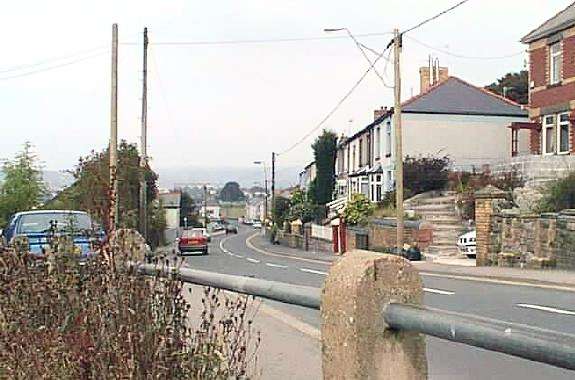Content can be downloaded for non-commercial purposes, such as for personal use or in educational resources.
For commercial purposes please contact the copyright holder directly.
Read more about the The Creative Archive Licence.
Description
Photography by John Ball - 22 September 1998
(with Agfa ePhoto307 digital camera)
Nantyglo is a former mining village situated in the ancient parish of Aberystruth between Brynmawr and Blaina at the head of the valley of the river Ebbw Fach. It is a long narrow village, built on the west-facing side of the valley. Most of the buildings along the old valley road are original, but new housing has been erected to the east. The newly-built A467 valley road by-passes Nantyglo. The name Nantyglo (Nant-y-glo) means "the coal brook" or "the charcoal brook" (nant = brook; y = the; glo = coal/charcoal). The name refers to the stream near where coal (or charcoal) was extracted.
Image 1:
A general view of Nantyglo, looking northwards along the old "New Road" up the valley towards Brynmawr. The land rises to the right of the picture, and falls away to the left.
Image 2:
Nantyglo Post Office at 69 King Street - This is the same address where the post office was founded c.1856 by James Allen (1828/9-1908) and opened by the local ironmaster, Henry Bailey of Nantyglo Ironworks.
Before 1856, residents of Aberystruth had to travel to Brynmawr for their postal business.
[My thanks to Clive Gardener for details of the history of Nantyglo post office – JLB 2016]
Image 3:
Some of the original housing in Queen Street, built in rows along the roadside.
mage 4:
A plaque marking the site of the former Hermon Baptist Chapel.
A medical centre has recently been built on the site of the chapel. I am indebted to two local men whom I asked for the whereabouts of Hermon Chapel. In reply I was treated to a fascinating lesson on local history. One of the men, aged 73, was born in Nantyglo and had lived there all his life.
Image 5:
Hermon Chapel graveyard, with the western side of the valley beyond.
The local council wants to landscape the graveyard, but this will involve repositioning the tombstones. A local councillor told me the council has run into difficulties because before the gravestones can be moved, attempts have to be made to contact all known relatives and descendants, many of whom emigrated to America years ago.
Image 6:
Plaque commemorating four local martyrs of the Newport Riots.
Near the plaque marking the site of Hermon Chapel is a second plaque commemorating four local heroes who were killed in the famous "Newport Riots", a Chartist uprising in 1839. The leaders of the movement were found guilty of treason and sentenced to death, but the death penalty was commuted to transportation and life imprisonment in a penal colony in Tasmania, Australia. Years later, the men were pardoned and set free.
Image 7:
Photography by Nadine, 2006
"Medhurst" (formerly Ty Meddyg), Farm Road, Nantyglo.
In November 2006, Nadine, a former resident of nearby Ebbw Vale, sent me the above photograph, and wrote:
The house in the photograph is "Medhurst". Its original name was Ty Meddyg, meaning doctor's house; it belonged to the doctor from the old Crawshay Bailey ironworks in Nantyglo. Its basement was where the surgical operations were done. As you can imagine, the old house must have been the scene of many life and death dramas over the years. I should think awful things had to be done to the men who were injured at the ironworks. Working at the ironworks must have been a very dangerous job and life wasn't easy. It doesn't bear thinking about, does it!
The old house is in Farm Road, almost opposite the Round Towers at the northern end of Nantyglo.
The house is now privately owned and is still included on tours of the area.
Acknowledgement
To Nadine, for allowing me to use her photograph of Ty Meddyg.


















Do you have information to add to this item? Please leave a comment
Comments (0)
You must be logged in to leave a comment